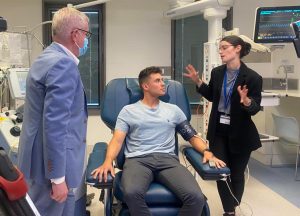Researchers at the Centre for Cancer Biology (CCB) have identified a key molecule for pancreatic cell function, malfunction of which may contribute to diabetes.
Professor Claudine Bonder leads a team at the CCB, an alliance between SA Pathology and the University of South Australia, and believes the discovery could provide new opportunities for early detection of type 1 diabetes.
Pancreatic islets are a collection of cells that produce blood sugar-controlling hormones.
Type 1 diabetes (T1D) is a chronic disease where islet cells can no longer produce insulin, the blood sugar-lowering hormone, and occurs due to a complex combination of factors, such as autoimmune, genetic, viral and environmental factors.
The research team has now identified a protein on the surface of islet beta-cells which plays a key role in regulating cell structure and function.
The discovery is a culmination of eight years of research and may provide new opportunities to combat type 1 diabetes.
The team genetically engineered mice to lack the desmoglein-2 (DSG2) molecule and proved to be more susceptible to developing diabetes.
“When that protein is lost, the islet cells don’t survive as well. They don’t attach to other cells as well, which is really important for communication with their environment,” said Professor Bonder, Head of the Vascular Biology and Cell Trafficking Laboratory.
Looking also at human islet cells, the team found that DSG2 is within the top 10 percent of all genes expressed by pancreatic islets.
“This suggests that it’s actually far more important to islet cell function than we appreciated,” said Professor Bonder.
The discovery of the importance of DSG2 could provide new opportunities for early detection of type 1 diabetes.
While outside the scope of this research program, the future could include opportunities for people with a family history of diabetes to be screened by checking for circulating fragments of DSG2 that may be cleaved in the early stages of T1D to serve as an early detection signal enabling earlier treatment or lifestyle interventions.
This research was funded by grants from the NHMRC and Diabetes Australia.



